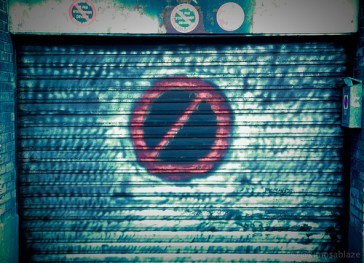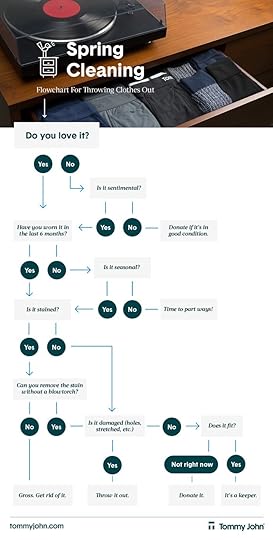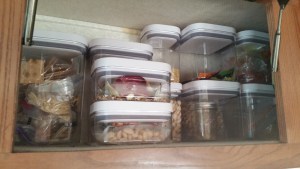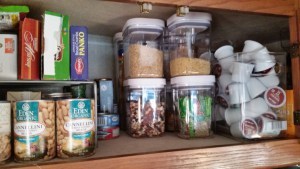Donna Smallin Kuper's Blog: The One-Minute Organizer Blog, page 8
July 10, 2017
Downsize and Organize Your Digital Clutter

Photo by Markus Spiske on Unsplash
What’s worse – physical or digital clutter?
Sorry, that was a trick question! While digital clutter is generally only visible to ourselves, it can take the same toll as physical clutter on our emotional health and well-being not to mention our daily productivity.
Purging and organizing data and files helps to ensure that both you and your devices are happier and healthier.
I have to admit that electronic organizing is not my favorite thing to do. Give me a closet and I’ll drop everything to organize it. But I typically only organize data when it becomes a problem like when I can’t save any more photos because my device is full. (Who knew that text messages took up that much room?)
So imagine my surprise when I got an email last week offering to share an article on how to downsize and organize digital clutter. Why yes, thank you very much!
The article offers some well-researched advice and strategies to reduce and organize electronic files on your computer and phone. Learn how creating folders is a simple way of sorting and organizing files so you can find them in seconds. You’ll also learn what files you can purge, how to set up a digital decluttering schedule, and options for backing up important files and documents.
If you’re anything like me, this is the kind of thing you keep putting off because you don’t have time or you’re too tired to deal with it. You can keep putting it off or do something today that your future self will thank you for…click on the image below to read the article.
Feel free to leave a comment below if you want to share your own tips and experiences with downsizing and organizing your electronic files. Or post a question and I’ll do my best to answer it.
Source: eReplacementParts.com
The post Downsize and Organize Your Digital Clutter appeared first on Declutter Your Life with Donna Smallin Kuper.
June 12, 2017
Simple Solutions to Declutter and Organize Your Hobby Room
This is a guest blog post jointly written with the good folks at OrganizedLiving.com.
 Hobby rooms are special places. It’s where creative minds go to unwind and make artistic visions come alive. But is your hobby space inviting you in or keeping you out?
Hobby rooms are special places. It’s where creative minds go to unwind and make artistic visions come alive. But is your hobby space inviting you in or keeping you out?
It’s hard to be creative when your workstation is so cluttered, there’s no room for you to work. And it’s frustrating when you can’t find what you need or discover that something got ruined because it wasn’t stored properly.
If you love your art, give your hobby space the attention it deserves. Here are some simple, inexpensive solutions to declutter and organize your hobby room, plus five ways to keep it organized.
Binders, clipboards, and boxes
Paper is the #1 source of clutter in any room. If you’re like most artists and crafters, you’ve got an abundance of paper – from magazines and reference books to pages torn from magazines and ideas and drawings on scraps of paper.
Corral multiple issues of your favorite magazines in magazine boxes. Organize boxes by magazine or subject.
But don’t save entire magazines for one or two articles. Tear out the ones you want to keep and place them in protective sheets in a 3-ring binder. Organize your binder with tabs to separate sections by subject. Or, if you have a lot of content, create separate binders for each subject.
Clipboards are a simple way to organize your notes and declutter your work space. Place them in a stepped desk organizer or hang them on the side of a bookcase or the wall nearest your workstation for easy access.
Shelving is a must
Every hobbyist needs a place to store supplies. If there’s a closet in your hobby room, research ideas for turning it into a beautifully organized storage space with cabinets and shelving that can be customized to fit your needs.
If you have a bookcase or other freestanding shelving unit available, designate different shelves and sections for various categories of items such as reference books and magazines. Things like scrapbooking paper can be organized by color, category, or type in wire mesh baskets or clear plastic storage bins that you can stack on shelves.
Storage cabinets on wheels are another way to store supplies, especially if you don’t have a dedicated hobby room. This option is also the perfect solution for when you want to keep certain supplies close at hand.
Glass jars and tin cans
Mason jars and tin cans in various sizes are useful for storing things like coloring pencils, markers, and pens. You can also use them to store paintbrushes or various size crochet or knitting needles. Arrange the jars or cans on shelves or keep your most often used items handy on your work table by placing them on a two-tier turntable.
Hooks and magnetic strips
Take advantage of wall space for storage that is as functional as it is attractive. With 3M Command Adhesive Hooks, you can hang tote bags with tools, supplies or projects. Another easy solution is to attach a magnetic strip to a metal filing cabinet and voila! You have a place to store metal tools.
5 easy ways keep your hobby space organized
Once you get your hobby space organized, keep it that way so that it’s always ready for you to practice your craft.
Label everything. Labeling serves as a visual reminder to put things where they belong. Label shelves, containers, and drawers.
Focus on just one or two hobbies. Which of your hobbies brings you the most pleasure? Consider focusing on the craft you enjoy most or do most often. Let go of the hobbies and supplies that no longer interest you like they once did. At the very least, pack them away to free up space.
Pare down your stash. If you’re like most crafters, you’ve been collecting craft supplies forever. But over time, you’ve learned that you prefer working with certain colors or textures or styles more than others. Consider donating to a fellow crafter or list them for sale or for free on Craigslist or Freecycle.
Re-evaluate your space periodically. Go through supplies every few months. Removing unused or un-usable tools and supplies will help free up space for the addition of new supplies.
Clean up regularly. Get in the habit of cleaning up as you work. When you get out your supplies, put them in plastic storage bin or basket that you can carry to your workstation and return when you are done. Or set a timer to take a break every hour or so to stretch your legs and do a quick clean-up. Most importantly, try to keep your workstation clear of everything but your current project.
The post Simple Solutions to Declutter and Organize Your Hobby Room appeared first on Declutter Your Life with Donna Smallin Kuper.
June 5, 2017
Decluttering and the Fear of Waste
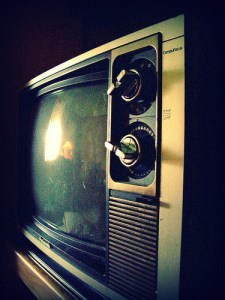
photo credit: Morgan Thompson Retro via photopin (license)
While I was shopping in a thrift store in my area, I found a book called Simplify your Life by a German author Werner Tiki Küstenmacher. He gave useful tips on how to simplify different areas of our lives and he started with the idea of decluttering and letting go of things.
I started to look for information on the topic and I found the blogs of wonderful people like Leo Babauta, who mentioned The Flylady and the idea of shining your sink. I read posts by Joshua Becker, Mike Burns, Courtney Carver and this one by Donna Smallin Kuper. The more I read, the more I agreed with them and started simplifying, decluttering and focusing on what was most important for me and my family.
I realized that the topic of simple living was not so common in Italy, so I decided to create my own blog in which I shared my experiences on simplifying. I often translated posts published by the above-mentioned American authors.
After two years, I had a wonderful house, still full of rooms and space but only with the things I love, use and like. It is much easier for me to concentrate and to focus on a task at a time. I am more productive and apart from being the mother of two teenagers, wife to a wonderful husband, active at church and a teacher of foreign languages, I also find the time to write posts on my blog, read books on personal development, organizing and simplicity.
Since the space around me is so clear with no clutter, I do not spend much time cleaning and doing housework. I find myself often reflecting on how this journey towards simplicity has immensely impacted my life for good.
I am a member of different groups on decluttering on Facebook and in one of these, a member shared her fear that decluttering was a way of wasting money and resources. She was afraid to let go of things because she had spent money on them and felt that throwing them away was wasteful.
I have been reflecting on this and I have come to realize that we are children of a generation who has always stressed the importance of keeping things “just in case.” Our parents and grandparents had experienced war and poverty so they felt this need to hold on to possessions.
But today we have a different situation. It is very easy for us to acquire things, clothes are much less expensive than they used to be, even technology is very affordable. So there is no need to keep things “just in case.”
The point is that we are wasting money if we keep things without using them, especially if they could be really useful for someone else. Realizing that our stuff can still be used by someone else should help us get rid of things more easily.
We had an old television which was working perfectly but was very heavy to move and was sitting unused in a room in the basement. We wanted to carry it to the recycling center in our area but we felt it was really a waste of money.
We put an ad on a website to sell it for $8 and we immediately received the reply of a family who came and got it. It would have been a waste if we had simply thrown the TV away, but in this way, we were able to find a new home for it.
I really encourage you today to find a place where your clothes, your children’s toys, kitchen tools can still be used: a family in need, neighbors or friends, or a local donation center. You will enjoy the freedom that comes with having fewer things to care for. And you will discover that letting go of things will be a joy for you and for the people around you.
 Elena Ferro is author of the blog Semplicità in Azione. She is a 44-year-old Italian teacher of German and English, wife and mother of two teens. She lives near Verona – the city of love – and recently discovered that a simple and decluttered life makes her really happy and serene. This post is an example of the posts she shares on her blog.
Elena Ferro is author of the blog Semplicità in Azione. She is a 44-year-old Italian teacher of German and English, wife and mother of two teens. She lives near Verona – the city of love – and recently discovered that a simple and decluttered life makes her really happy and serene. This post is an example of the posts she shares on her blog.
The post Decluttering and the Fear of Waste appeared first on Declutter Your Life with Donna Smallin Kuper.
May 30, 2017
Planning to Move? How to Make Your Next Move the Easiest Ever
According to the U.S. Census Bureau, more than 40 million Americans – about 1 in 9 – move each year. Are you planning to move?
Take it from someone who moved 12 times in 32 years – the best thing you can do is start packing as soon as you know you are moving. At Moving.com, you can order boxes and have them delivered. Use the handy calculator to help you figure out how many boxes you need. Or look for free boxes at Freecycle.org or Craigslist.org. You’ll also need packing paper and good-quality packing tape plus a tape gun.
Start packing as soon as you know you are moving...but don't pack everything!
Click To Tweet
Start packing items you are not currently using which might include out-of-season clothing, footwear, and linens as well as books and infrequently used kitchen wares. Label each box with the room it will go to in your new home. Write the room name on all four sides of the box. And do yourself a favor that will save your back – use smaller boxes to pack heavy items like books and dishes. Save the larger boxes for lighter items such as bedding and decorative items.
But don’t pack everything! Take this fantastic opportunity to pare down your belongings to those things you love and use (and can use in your new place). Why waste time packing and paying to move stuff that will just clutter up your new home?
Forget about having a yard sale – it’s time-consuming and rarely worth the effort. Instead, search for “[insert your city or region] online yard sale” on Facebook where you can list items for sale. Or try selling items on the OfferUp or LetGo app. Or make it really easy on yourself and donate everything you decide not to take with you. Go to DonationTown.org to find a local charity that will even come and pick up your stuff. What could be easier?
Be sure to pack a “move day” box or or small suitcase for things you want to keep handy on move day, such as a box cutter, snacks, phone chargers, maybe even your toothbrush and pajamas so you don’t have to open a gazillion boxes to find them that first night. I always unpack bedding and make my bed first so I don’t have to do it at the end of an exhausting day.
Here are a few more tips on how to ensure a smooth move – thanks to A & C Brothers Moving & Storage in Phoenix, Arizona! 
The post Planning to Move? How to Make Your Next Move the Easiest Ever appeared first on Declutter Your Life with Donna Smallin Kuper.
May 22, 2017
Some of My Favorite Cleaning Products + a Spring Cleaning Giveaway!
I remember washing dishes one night when I was about 11 or 12 years old. I was really frustrated and called out to my mother because I just couldn’t seem to get this one pan clean. She replied, “Try a little elbow grease!” Hmmm, I thought. I wonder where she keeps that? LOL!
As a certified House Cleaning Technician, I’ve tested a lot of cleaning products from a variety of manufacturers. Some of my favorite cleaning products are from a Michigan-based company called Armaly. They’re the makers of Brillo products. You’re probably familiar with good old-fashioned Brillo Steel Wood Soap Pads – who isn’t? You’ve got to like the way they cut through tough messes – whether it’s rice you accidentally burned to the bottom of your favorite pot or for cleaning the drip pans on your electric stove top. 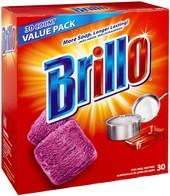
But here’s another use for Brillo pads that can actually help keep you and your family safe from harm. You’ve probably heard that grill brush bristles can fall off and be left behind on the grate. That’s dangerous because those bristles can get caught in food, resulting in accidental ingestion and hospitalization. To eliminate that potential hazard, scrub your grill grate with a Brillo pad and a little water and then rinse.
By the way, I discovered awhile ago that Brillo soap pads are also the fastest, easiest way to clean soap scum off your glass shower doors and walls! Just wet the pad and wipe. Then rinse. Job done!
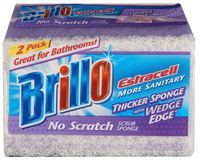 Brillo also makes a line of Estracell® sponges with a unique cell structure that rinses cleaner and dries out faster, eliminating the perfect breeding ground for bacteria and fungal growth that cellulose sponges create. I use the No Scratch Scrub Sponge with Wedge Edge to rid my bathroom and kitchen of germs and leave every surface sparkling clean. The no scratch material is designed to clean delicate surfaces including non-stick cookware, glassware and countertops. The wedge edge reaches deeper into those tough areas with its unique shape to clean cracks and cervices on countertops and in shower stalls.
Brillo also makes a line of Estracell® sponges with a unique cell structure that rinses cleaner and dries out faster, eliminating the perfect breeding ground for bacteria and fungal growth that cellulose sponges create. I use the No Scratch Scrub Sponge with Wedge Edge to rid my bathroom and kitchen of germs and leave every surface sparkling clean. The no scratch material is designed to clean delicate surfaces including non-stick cookware, glassware and countertops. The wedge edge reaches deeper into those tough areas with its unique shape to clean cracks and cervices on countertops and in shower stalls.
Another type of sponge I use often is the eraser type sponge. Have you ever tried one? Funny story, I was using a Brillo Erase & Wipe sponge to wipe off black scuff marks on a wall when my husband came walking by and asked what I was doing. He said, “Let me try that.” He thought he was going to have to re-paint the wall, so he was thrilled – and so was I because he finished the job for me.
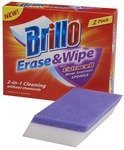 But did you know that you’re supposed to rinse after using an eraser-type sponge? Otherwise, you’re leaving behind a harmful residue on the surface. The Brillo Erase & Wipe has a white side that is the erasing side and the purple side contains the Estracell® More Sanitary wiping layer to wipe away residue. Because of the unique cell structure of the erasing side, no chemicals are needed, just water. These sponges make quick work of cleaning coffee stains from inside coffee cups not to mention cleaning dirty fingerprints from around doorknobs.
But did you know that you’re supposed to rinse after using an eraser-type sponge? Otherwise, you’re leaving behind a harmful residue on the surface. The Brillo Erase & Wipe has a white side that is the erasing side and the purple side contains the Estracell® More Sanitary wiping layer to wipe away residue. Because of the unique cell structure of the erasing side, no chemicals are needed, just water. These sponges make quick work of cleaning coffee stains from inside coffee cups not to mention cleaning dirty fingerprints from around doorknobs.
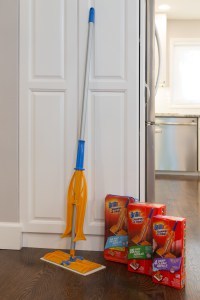 A few years ago, at the annual Home and Housewares Association Show in Chicago, I watched a demonstration of Brillo’s newest invention – the Brillo Sweep & Mop. This mop can be used to “sweep” up dust, debris, even pet hair with the dry mop pad.
A few years ago, at the annual Home and Housewares Association Show in Chicago, I watched a demonstration of Brillo’s newest invention – the Brillo Sweep & Mop. This mop can be used to “sweep” up dust, debris, even pet hair with the dry mop pad.
When you want to wet mop your floor, you just press the mop head into the box of wet pads and let Brillo’s Deep Clean Estracell sponge clean up dirt fast to let the beauty of your floors can shine through. I have since tried this mop in my home and what I love is that it’s fast and easy, the swivel head lets you get under and into tight spots and it leaves no residue behind.
Watch this quick video to see the amazing Brillo Sweep & Mop in action!
Feeling lucky? Enter my Spring Cleaning Giveaway for a chance to win a Brillo Sweep & Mop! Hurry…this giveaway ends at midnight Pacific Time on Monday, May 29. Winners will be notified within 48 hours.
The post Some of My Favorite Cleaning Products + a Spring Cleaning Giveaway! appeared first on Declutter Your Life with Donna Smallin Kuper.
May 16, 2017
7 Reasons Why Clutter Accumulates – and How to Clear the Clutter
Clear the Clutter, Find Happiness – that was the title of a keynote presentation I delivered earlier this month. In that talk, I presented some of the most common reasons why clutter accumulates – and some simple strategies for making it stop. Which of these 7 reasons are the reason(s) why clutter has accumulated in your home?
1. Later-it-is – That’s when you set something down and tell yourself that you’ll put it away later. It might be shopping bags, mail or other papers, your coat, your keys, your clothes. How to put a stop to later-it-is: Get in the habit of asking yourself: Is this where this belongs? Don’t just put it down. Put it away.
2. Homelessness is another reason why clutter accumulates. How can you put something away if it doesn’t have a home? You have to find homes for the homeless. Or in other words, find a place for everything so that you can always put everything in its place. Be mindful about the plight of the homeless when you go shopping. Before you buy something, you should know exactly where it’s going in your home – or what you plan to remove to make room for it.
3. Fear creates clutter – You think, “I might need this someday.” Right? Well, maybe you will. But if you haven’t needed it in a year – or 20 years – you probably won’t need it in the next year or 20 years. And if you do, could you maybe borrow it from a friend? Sure. A good question to ask yourself is “What’s the worst possible thing that could happen if I needed this again?” You could probably beg, borrow or steal – I mean buy – another one. Right?
4. Is guilt contributing the accumulation of clutter in your home? You think about how much you paid for something – or overpaid – and you hang on and hang on to it. The thing is, there’s a great second market for items that are current and in excellent condition – things like cell phones and clothing. But the longer you hold on to them, the less they’re worth. Here’s a helpful guideline that I learned from The Minimalists: If you can get it again in under 20 minutes for less than $20, let it go. Sell it or donate it and take the tax write off. Boom!
5. Not knowing what to do with stuff. This is a big one. But guess what? You don’t have to take on the job of figuring out what to do with stuff because there are organizations that are really good at that – places like Goodwill and The Salvation Army. And they’ll even come and get it from your driveway! You don’t have to find new homes for your stuff. All you have to do is go to Donationtown.org to find a charity near you that will pick up for free.
6. Perfectionism – People ask if my house is perfectly organized. It’s not perfectly organized because perfection isn’t necessary. If you’re a perfectionist, you need to get out of your own way. Perfect is not the goal. Done is perfect. And the sooner you start clearing clutter, the sooner you’ll be done.
7. Lack of time – You know what? You’ll never FIND time for organizing. You have to MAKE time. Organizing is one of those things that we tend to put off because we don’t have time right now. I don’t know what makes us think we’ll have more time later. It only looks like that right now. But you know as well as I do that by the time you get from “now” to “later,” that imaginary block of free time will have vanished. Here’s what I suggest: pick an area or project that needs organizing and then commit to spending 15 minutes a day on it. Make an appointment with yourself. Write it in your daily planner and honor that appointment as you would any other appointment. Now, 15 minutes may not seem like a lot of time. But do the math: 15 minutes a day adds up to one hour and 45 minutes a week which is 7 hours a month. You can clear a lot of clutter in 7 hours!
Can you think of any other reasons why clutter builds up? Leave a comment below!
photo credit: kimosablaze21 Forbidden! tk-1 via photopin (license)
The post 7 Reasons Why Clutter Accumulates – and How to Clear the Clutter appeared first on Declutter Your Life with Donna Smallin Kuper.
April 12, 2017
Help with Cleaning Out Your Closet
The change of seasons is a good time to clean out your closet. As you put away your winter clothes, be honest with yourself about what to keep. If you didn’t wear something once all last winter, you’re not likely to wear it next year. Seriously consider letting it go to make more room for the things you do wear and love.
I have this one pullover blouse that I bought about 12 years ago. Every time I clean out my closet, I think maybe it’s time to let it go. But I still love it and wear it and get compliments on it. So it’s a “keeper.”
I actually clean out my closet and drawers pretty regularly. My rule is that when I buy something new, something has to go. I noticed the other day that 3-4 pairs of socks I wear for exercise had holes in the toes. So I bought four new pairs and tossed the old ones. A similar trick of mine is to keep only as many hangers as I need to hang things in my closet. If I buy something new, I need to let go of something so I have a free hanger.
If your cast-offs are in good condition, donate them. The easiest way to do that is to schedule a pickup at PickUpPlease.org, an organization that generates funds to help Vietnam Veterans of America. It’s a good feeling to know that you are helping others. Alternately, you may decide to sell items at a nearby consignment store and use whatever you make to pay down debt, pad your bank account, or shop for new clothes where you sold your old ones.
Schedule some time to go through your closet and pare down your wardrobe. Pull out your favorite items of clothing – the keepers. If you have to think more than a few seconds about what to keep and what to toss, you probably won’t miss it if you toss it in the donate/sell pile.
Find more of my favorite closet cleaning tips in this Today.com article.
Need more help making those tough decisions? Below is a flowchart that will simplify your decision-making. What do you think? Is it helpful?
The post Help with Cleaning Out Your Closet appeared first on Declutter Your Life with Donna Smallin Kuper.
April 11, 2017
What’s on Your Spring Cleaning Checklist?
I had the pleasure of visiting Tuzigoot National Monument near Sedona, Arizona last week while on vacation. Tuzigoot was home to a tribe of Sinagua Indians. No one knows why they left, but the home they left behind leaves many clues to how they lived and worked together and survived in the desert.
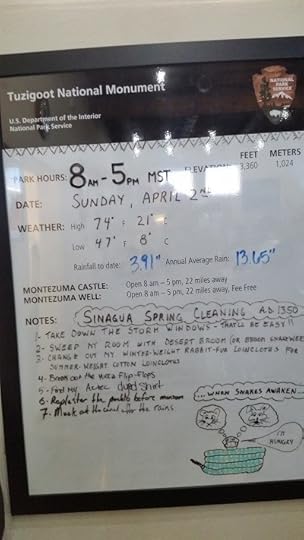 I had to laugh when I saw the sign (pictured at right) at the entrance. Check out the spring cleaning checklist. Hysterical! Right click on the photo to enlarge it if you can’t read it.
I had to laugh when I saw the sign (pictured at right) at the entrance. Check out the spring cleaning checklist. Hysterical! Right click on the photo to enlarge it if you can’t read it.
Here’s my spring cleaning checklist:
Wash windows inside and out
Clean window screens
Clean carpets
Clean wood cabinets
Have drapes professionally cleaned
Clean out my closet and drawers
No mucking out the canal after the rains for me!
My plan is to set aside a few hours to tackle one project at a time. But I don’t plan to go it alone. I’ll let the professionals handle the drape and carpet cleaning. And I’ll delegate the outside window cleaning job to my Director of External Affairs (my husband) in exchange for a foot rub.
What’s on your spring cleaning checklist?
In a 2013 survey conducted by Echo Research on behalf of the American Cleaning Institute (ACI), 71 percent of those responding said that they planned to clean out closets and drawers. Keep an eye out for tomorrow’s post with a helpful guide for deciding what to keep and what to toss.
The post What’s on Your Spring Cleaning Checklist? appeared first on Declutter Your Life with Donna Smallin Kuper.
March 27, 2017
Taming the Paper Tiger
When I ask people about their most overwhelming organizing challenge, paper is cited most often. We all get so much paper. It enters our lives in a variety of forms: paper comes in the daily mail, in our children’s backpacks, and via technology (faxes, email print outs, web search results we print).
We also get paperwork (receipts, warranties, and/or manuals) every time we make a purchase and as a result of our healthcare needs (doctor bills, insurance claim forms, EOBs, drug interaction statements, lab work results, etc.). It accumulates rapidly. Personally, I think papers reproduce in the dark at night! Doesn’t it always seem like the paper piles are bigger each day?
How Do I Know What to Keep?
One of the main reasons paperwork feels so overwhelming is that many people are uncertain what must be kept, and what can safely be tossed.
There is a lot of paperwork that is redundant, and it only needs to be saved once. For example, once you receive your W2 statement, you can shred the prior year’s paystubs (unless you are applying for a mortgage in which case you should hold onto the most recent 3 months of stubs). Once you receive your 1098 statement, the previous 12 months of mortgage statements can be shredded. Most report cards are cumulative; the year end card will contain the grades from the previous 3 marking periods, so those from earlier marking periods can be tossed.
Certain documents need to be kept forever, or close to it. For example, year-end investment statements need to be saved for 7 years after the last investment is liquidated so plan to keep for a very long time. Documentation of capital improvements made on your home should be saved for 7 years after you sell that home. So again, you are most likely saving for the long-haul. Vital documents (such as birth certificates, death certificates, marriage licenses, divorce decrees, military discharge papers) should be kept forever.
Some paperwork needs to be saved for a finite period of time as tax back-up. The general rule of thumb is 7 years (although some accountants say 3 years is sufficient, so check with your financial advisors). In the case of a recent organizing job with over a dozen boxes of paperwork, we saved the last 7 years of tax returns and tax back-up (2009-2015) and shredded the older documents.
Still other paperwork doesn’t need to be saved at all (for example, junk mail and old grocery shopping lists) or should be saved only for a limited period of time (i.e., certain receipts).
If you find yourself inundated with magazines and/or newspapers, consider paring down the number of publications to which you subscribe, consider getting the issues in only a digital format, and definitely toss the old issues.
How Should I Store the Papers I Do Need to Keep?
The answer depends on both what the papers are, and how much storage space you have. It also depends on whether you are comfortable with technologically storing documents through cloud storage and/or scanning documents.
You definitely do not want to store paperwork on your dining room table or kitchen counters. Create an inbox to corral the current mail. Set up a filing system (traditional filing cabinet, a file box, or a file ottoman are all options) for the papers that need to be saved and accessed.
Vital documents, and anything with a raised seal, should be stored in paper form and should be accessible. You can certainly scan a copy to store electronically or in the cloud, but these documents should be saved in paper form as well. You may want to keep these important documents in a fire-resistant box or safe.
Tax returns and tax back-up can be saved in either paper or electronic form. If you are saving hard copies, feel free to keep a box of historic tax paperwork on a shelf in a closet, or in the attic or basement. It is unlikely you will need to access this paperwork, except in the case of an audit, so it doesn’t need to take up valuable “real estate” in your filing cabinet.
Some people prefer using binders rather than file folders. Designate a shelf to store the notebooks, and create one for each major area: Medical, Investments, Household Reference, etc.
Take advantage of programs such as Evernote, Dropbox or Pinterest for documents such as recipes, a DIY project, or articles about topics of interest, rather than ripping pages from a magazine or printing them from a website. Storing this type of paperwork online makes it easier to access, and takes up less space.
Remember to create regular chunks of time to stay on top of the paperwork (15 minutes twice a week should do it) so it doesn’t become overwhelming.
 Deborah Gussoff brings years of corporate and personal experience to the professional organizing industry. A Certified Professional Organizer®, she’s one of only 200 organizers in the country to achieve this designation. Deborah founded her company, In Order, Inc., in 1994 to help individuals and businesses gain more time and space by organizing their environments and lives. She believes that, with a little help, every person can lead an organized life. Like In Order on Facebook www.facebook.com/inorderorganizing for organizing tips and inspiration or visit her website for more information and resources.
Deborah Gussoff brings years of corporate and personal experience to the professional organizing industry. A Certified Professional Organizer®, she’s one of only 200 organizers in the country to achieve this designation. Deborah founded her company, In Order, Inc., in 1994 to help individuals and businesses gain more time and space by organizing their environments and lives. She believes that, with a little help, every person can lead an organized life. Like In Order on Facebook www.facebook.com/inorderorganizing for organizing tips and inspiration or visit her website for more information and resources.
This guest blog post was originally published at InOrder.com/blog.
The post Taming the Paper Tiger appeared first on Declutter Your Life with Donna Smallin Kuper.
March 16, 2017
The Ultimate Kitchen Cabinet Decluttering Checklist
Here’s a great spring cleaning project – declutter your kitchen cabinets. I did – and what a difference!
I started with my snack cabinet. I had three large, lidded bins that I labeled Sweets, Crackers & Chips, and Dried Fruit & Nuts. Even though the bins were labeled, we would forget what we had in there because the bins were not see-through and the labels were too generic. And I couldn’t always fit everything into the bins.
Recently, I decided to splurge on a set of Oxo Pop-up Containers. Oh. My. Goodness.
I have to admit that I’ve always loved the look of these clear plastic module containers, but thought they were a bit pricey. They are. But now that I have them, I don’t regret spending the money one bit. They really do save room which is especially important to me since storage space is at a premium in our small home. Plus it’s easier to see what I have and, because the containers are airtight, the contents stay fresher, longer.
Here’s a photo of my snack cabinet:
So then, you know what did? I liked these Oxo Pop-up Containers so much that I bought another set to organize my pantry cabinet. Again, I ended up with more room – enough to store my food processor and popcorn maker at the far side, making it easier for me to get to these appliances when I need them. I only use these appliances once or twice a month if that. But where they were before, I had to get down on my hands and knees to get them out. And I’m not getting any younger!
Here’s a photo of my pantry:
I’d already pared down my kitchenware when we sold our home to hit the road as full-time RVers. So I didn’t need to do any decluttering in those cabinets. So that was that. Job done.
What’s in your kitchen cabinets? Are they in need of some decluttering? Yes? Then I have a little gift for you. It’s the Ultimate Kitchen Cabinet Decluttering Checklist. I didn’t create it, but honestly, it reads like a page straight out of my book, Organizing Plain & Simple. I think you’ll find this checklist below very helpful for getting your kitchen in order.
Happy decluttering! Let me know how you make out or if you have any specific questions about decluttering your kitchen cabinets.
Checklist courtesy of Tri-Star Cabinet and Top Co., Inc.
The post The Ultimate Kitchen Cabinet Decluttering Checklist appeared first on Declutter Your Life with Donna Smallin Kuper.
The One-Minute Organizer Blog
- Donna Smallin Kuper's profile
- 45 followers


